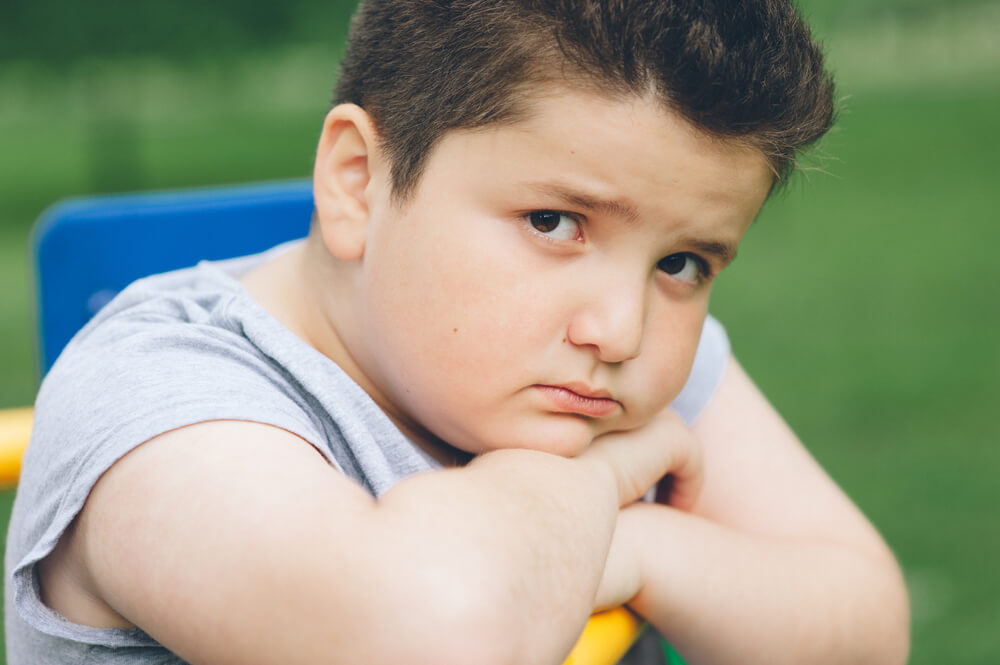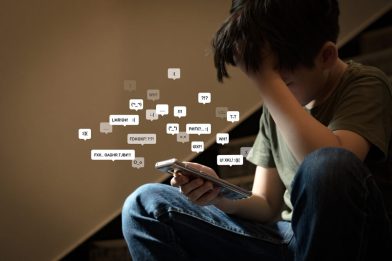What Is a “Big Back”: Is It Just Slang or Something More?

When your child comes home and mentions “big back,” you may find yourself wondering about the big back meaning. What exactly does “big back” mean, and should you be concerned about its implications?
In today’s digital age, where social media trends spread like wildfire, it’s easy to feel out of the loop. But don’t worry, we’re here to help. This post breaks down the meaning of “big back,” explores its origins, and discusses whether it’s something to be worried about.
By the end, you’ll have a clear understanding of what “big back” means and how to navigate these conversations with your child.
Contents:
- What Does “Big Back” Mean?
- Is the Term “Big Back” Harmful?
- What To Do When Someone Fat Shames Your Child
- How To Handle Your Child if They Use Harmful Language
- FAQs
What Does “Big Back” Mean?

AN Photographer2463/Shutterstock.com
In the world of kids and teens, “big back” has nothing to do with anatomy or upper body posture. Technically, it also doesn’t have anything to do with someone having a large back.
Instead, it’s newer slang used to describe someone who is perceived as having a large body or being overweight. It also refers to their eating habits or largeness in general. Think of it as a modern twist on name-calling, but wrapped in the digital age’s colorful slang. “Big back” is often used in a joking manner, but like many jokes, it can quickly turn mean-spirited and hurtful.
The term “big back” didn’t just appear out of thin air. It sprouted from the fertile ground of social media, particularly TikTok. Kids and teens often adopt phrases they find funny, catchy, or trending. This term likely evolved from the countless videos and memes that populate their feeds daily. It’s a reflection of how quickly language and trends can spread in the digital world.
TikTok is a breeding ground for viral trends, and “big back” is no exception. You might have seen videos where users jokingly refer to someone as having a “big back,” accompanied by humorous comments or exaggerated expressions.
For example, a video might show someone struggling to fit into a tight space, with a caption like, “When your friend has a big back” or “When your friend is a big back” (it can be used either way). These videos often garner thousands of likes and shares, reinforcing the term’s popularity.
Who Uses “Big Back” and How?

SynthEx/Shutterstock.com
Primarily, the term is used by kids and teens within their social circles. It’s part of their digital vernacular, a way to bond over shared humor.
However, it’s not just limited to them; older teens and even young men and women might use it in a lighthearted context. What starts as an innocent joke among friends can quickly spread, especially when it’s seen as cool or funny.
Unfortunately, as is the case with most social media trends, this is a piece of lingo that’s even spread to the younger crowd, with some parents noticing it in kids as young as late elementary or middle school.
Again, “big back” is mostly used in a joking manner, but it can easily cross the line into hurtful territory. It’s thrown around in casual conversations, online comments, and even within friend groups. The intention can vary—sometimes it’s just a joke and other times it can be a form of teasing or even bullying.
Examples from TikTok
Curious about how “big back” might be used in context?
A TikTok user might create a video showcasing a friend failing to squeeze through a narrow door, adding the caption, “When you’ve got a big back.” The comments section would then explode with laughing emojis and similar jokes. While this might seem harmless to some, the person being referred to might feel self-conscious or hurt.
@baylee.bestt big backs unite #fyp #bigback #trending ♬ Big Backs Unite – knotwin
Another example could be a scene where a group of teens is trying on clothes, and one girl is singled out with the comment, “Looks like we’ve got another big back here!” This kind of content can receive thousands of likes, making the term more widespread but also more harmful.
In many instances, “big back” is used to describe someone who’s eating or their eating habits, referring to how much food someone eats in terms like “big back behavior.”
Is the Term “Big Back” Harmful?

Alex_Maryna/Shutterstock.com
At first glance, “big back” might seem like a harmless joke, but it can be damaging—especially to those who are self-conscious about their bodies. This kind of language can perpetuate body shaming and contribute to low self-esteem, particularly in females. It’s crucial to recognize that what seems funny to one person can be deeply hurtful to another.
The primary victims of such slang are often those who are already vulnerable or insecure about their appearance. Kids and teens are particularly susceptible to peer pressure and societal standards of beauty. Being called a “big back” can exacerbate feelings of inadequacy and lead to a negative self-image. This isn’t just limited to the playground or school corridors; online platforms amplify the reach and impact of such terms.
While your teen might accuse you of overreacting when you call them out for using “big back,” saying it’s just a joke, the reality is that it isn’t a positive term. It needs to be addressed.
Using these kinds of terms casually can normalize harmful behavior. It can make kids feel isolated and bullied, leading to serious emotional and psychological effects.
It’s important for both parents and kids to understand the weight of their words. Children who are ridiculed based on their appearance can develop long-term issues such as anxiety, depression, and eating disorders. That’s true even if the person using the phrase “big back” doesn’t intentionally mean to do any harm—and is in fact just joking.
What To Do When Someone Fat Shames Your Child

Ruslan Shugushev/Shutterstock.com
It’s one thing if your child is using the phrase “big back” and you’re uncomfortable with it—you can address that together. But dealing with your child being fat-shamed through the use of the phrase “big back” (or any other derogatory commentary, for that matter) can be equally, if not more so, challenging.
If your child experiences fat shaming in school or other offline settings, it’s essential to address it immediately. Encourage open communication with your child, making sure they feel safe sharing their experiences and are able to stand up tall against bullies who target overweight people.
Speak to teachers or school administrators to make sure something is done about this kind of behavior. Strategies like role-playing can help your child practice how to respond to bullying in a safe environment.
Tips for Online Interactions
Online, things can be a bit more tricky. The digital world can be a breeding ground for bullying, and it can be tough to keep tabs on what your child is doing or what other teens are saying to them.
The good news is that using tools like Kids360 can help monitor your child’s online interactions and protect them from harmful content. Kids360 not only allows parents to track and manage their children’s online activities but also offers features like screen time control and task-based rewards, encouraging positive and productive use of digital devices. This creates a safer and more balanced digital environment for your child.
Outside of keeping the lines of communication open with your child, you may also want to consider setting up privacy settings on social media platforms to limit who can contact your child. By combining these strategies with tools like Kids360, you can help ensure your child has a safer, healthier experience online.
Download Kids360 today and explore its powerful features designed to protect and engage your child. With its intuitive interface and unique educational tasks, Kids360 helps balance online safety with personal development. Try it now for free!
Always Offer Emotional Support
Above all, provide emotional support.
Reassure your child that their worth is not defined by their appearance. For example, you might say, “You’re so much more than what anyone says about how you look. You’re kind, talented, and brave, and those are the things that truly matter.” Encourage positive self-talk by helping them come up with affirmations like, “I am strong,” “I am capable,” or “I am loved just as I am.” Engage them in activities that build their confidence and self-esteem, such as enrolling them in a sport they enjoy, encouraging them to pursue a hobby like drawing or playing a musical instrument, or participating in community service projects where they can see the positive impact they make on others.
Remind them of their strengths and abilities, and create an open space for talking about their feelings without fear of judgment.
Practical Steps for Protection

fizkes/Shutterstock.com
Aside from the advice listed above, here’s a recap of a few tips to follow (both online and offline) to protect your child:
- Monitor Online Activity: Regularly check your child’s social media accounts and online interactions.
- Limit Social Media: If fat-shaming is happening online, consider setting boundaries around social media use. This could involve limiting a child’s time on certain platforms to reduce exposure to harmful content. Apps like Kids360 can also help you stay informed about your child’s online interactions, giving you another layer of protection.
- Educate on Privacy Settings: Teach your child how to use privacy settings on different platforms to control who can see their content and interact with them.
- Encourage Reporting: Instruct your child on how to report bullying or harmful content on social media platforms.
- Seek Professional Help: If the bullying persists or significantly impacts your child’s well-being, consider seeking guidance from a counselor or therapist.
How To Handle Your Child if They Use Harmful Language

DimaBerlin/Shutterstock.com
If you discover that your child is using terms like “big back,” it’s important to start by getting an understanding of why.
Are they mimicking what they see online? Are they trying to fit in with peers?
Understanding the root cause can help you address the behavior effectively. Sometimes, children use hurtful language to deflect attention from their insecurities or to gain social acceptance.
Open a dialogue with your child about the impact of their words. Explain why this kind of language can be harmful and encourage empathy. Use real-life examples or stories to illustrate the consequences of body shaming. Encourage your child to think about how they would feel if they were the target of such remarks.
Encourage positive behavior by reinforcing kindness and respect. Praise your child when they use inclusive language and show consideration for others. Lead by example, demonstrating how to interact with others respectfully. Role-playing different scenarios can also help them practice responding positively in various social situations.
Finally, do your best to educate them on the importance of empathy.
Here are some strategies.
Use Real-Life Examples

Daisy Daisy/Shutterstock.com
One of the most effective ways to help your child understand the impact of fat shaming is to share real-life examples. You can talk about an influential person your child likes or other public figures who have spoken out against body shaming and how it affected them. For instance, singer Adele and actor Jonah Hill have both publicly addressed how hurtful comments about their bodies affected their self-esteem and mental health.
Example: “Remember when we read about that influential person who was teased about her weight? She talked about how those comments made her feel unworthy, even though she was incredibly talented. It took her years to build back her confidence.”
This can help your child empathize with others and understand the seriousness of fat shaming.
Discuss the Impact

Violator22/Shutterstock.com
Explain to your child that fat shaming isn’t just hurtful in the moment—it can have long-lasting effects on a person’s mental and emotional well-being. People who are repeatedly shamed for their bodies may develop low self-esteem, anxiety, depression, or eating disorders. They might also avoid social situations or activities they once enjoyed due to fear of being judged.
Example: “Imagine if someone kept telling you that you weren’t good at math. After hearing it enough times, you might start to believe it, even if it’s not true. That’s what happens with fat shaming—people start to believe the negative things said about them, and it can make them feel really bad about themselves.”
By discussing these impacts, you can help your child see the gravity of their words or actions, or understand why it’s important to stand up against body shaming when they see it happening to others.
Encourage Apologies

KOTOIMAGES/Shutterstock.com
- Guide Your Child to Apologize Sincerely: If your child has participated in fat shaming, it’s crucial to encourage them to apologize. Teach them that a sincere apology can go a long way in repairing the harm done. Explain that an apology should acknowledge the hurt they caused, take responsibility for their actions, and express a genuine desire to make things right: “If you ever say something that hurts someone’s feelings, it’s important to apologize. You can say, ‘I’m sorry for what I said. I realize it was hurtful, and I didn’t mean to make you feel bad.’ It’s not easy, but it shows that you care about how the other person feels.”
- Making Amends: Encourage your child to also think about ways to make amends beyond just saying sorry. This could involve being more supportive of that person in the future, or even speaking out against similar behavior from others: “If you’ve hurt someone with your words, sometimes just saying sorry isn’t enough. Think about how you can show that person you really care—maybe by being kinder to them, or by standing up for them if someone else says something hurtful.”
As if we didn’t have enough on our plates as parents, it seems as though new slang is being invented every day—and it’s our job to keep up with it to keep our kids safe. While it can be tricky, understanding the phrase “big back” and its implications is crucial for modern parenting.
Although it’s easy to brush off such terms as harmless slang, the reality is that they can have significant emotional consequences. Being aware of the language your child uses and encounters can help you guide them toward more respectful and empathetic communication.
Stay informed about the language and trends your kids are exposed to. Foster open communication, encouraging your children to share their experiences and feelings. Equip them with the tools and knowledge to stand against bullying, both offline and online. Consider using the Kids360 app to monitor your child’s online activity, helping you stay aware of any concerning behavior or trends they might encounter. Be proactive in teaching them the importance of kindness and empathy in all their interactions.
Share this post with fellow parents, and let’s create a supportive community where our children can grow up feeling confident and valued. Join comments to discuss how we can collectively work towards a more inclusive environment for our kids.
We can’t always control what our kids are doing—but by educating them on how to be safe, kind, and respectful to others, we can do our part in creating a better environment for everyone, both online and off.
FAQs

Monkey Business Images/Shutterstock.com
What does big back slang mean?
“Big back” is a modern slang term that means someone eats a lot or has a large appetite. Although it originally came from British and AAVE slang referring to a large posterior—popularized by Sir Mix-a-Lot’s “Baby Got Back”—its current meaning shifted toward describing excessive eating, especially after a viral TikTok video series.
The phrase is now often used negatively, referring to “big back behavior,” a term highlighted by Charlamagne Tha God when discussing overeating shown in the viral Who TF Did I Marry? series.
Where did big back come from?
The “big back” term is believed to have originated as a part of British slang but was popularized on social media sites like TikTok. Its popularity has spread among younger generations, like Gen Z and Gen Alpha, and it’s often used to refer to overweight people.
What is this big back trend?
The “big back” trend originated on social media platforms like TikTok, where users create humorous content referring to someone’s body size. While popular, it’s important to recognize its potential to harm.
What does it mean when someone calls you a bigback?
Being called a “big back” typically means that someone is referring to you as overweight, particularly in the upper body or booty. It’s a term that can be considered body shaming.
What does have back mean in slang?
“Have back” in slang can mean having someone’s support or protection. It’s different from “big back” and is used in a positive context.
What is the meaning of back slang?
The term “back slang” can have a few different meanings. It can refer to a specific sort of slang in which words are essentially inverted, like saying “terwa” instead of “water.” It may also be connected to the modern slang term “big back,” which actually started as a British slang term for large buttocks. It’s now often used as a derogatory term for overweight people.
What does big mean in slang?
Big can mean a lot of different things in slang. It may simply mean the literal large or fat or of considerable size, but it can also mean successful or impressive. Someone might describe an influential person as “big” for example, which is a way of saying that the influential person in question has power or success in their field.
The picture on the front page: Dragon Images/Shutterstock.com
Проверьте электронный ящик




















